User:JustinTime55/sandbox/Spacecraft
| It has been suggested that Robotic spacecraft be merged into this page. (Discuss) Proposed since December 2010. |

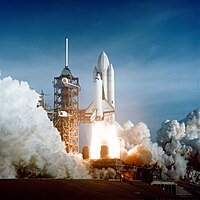
A spacecraft or spaceship is a craft or machine designed for spaceflight. Spacecraft are used for a variety of purposes, including communications, earth observation, meteorology, navigation, planetary exploration and transportation of humans and cargo.
On a sub-orbital spaceflight, a spacecraft enters space and then returns to the surface, without having gone into an orbit. For orbital spaceflights, spacecraft enter closed orbits around the Earth or around other celestial bodies. Spacecraft used for human spaceflight carry people on board as crew or passengers, while those used for robotic space missions operate either autonomously or telerobotically. Robotic spacecraft used to support scientific research are space probes. Robotic spacecraft that remain in orbit around a planetary body are artificial satellites. Only a handful of interstellar probes, such as Pioneer 10 and 11, Voyager 1 and 2, and New Horizons, are currently on trajectories that leave our Solar System.
Spacecraft and space travel are common themes in works of science fiction.
History
[edit]The first Earth orbiting satellite was Sputnik 1, which was launched 4 October 1957, and remained in orbit for several months.[1] While Sputnik 1 was the first spacecraft to orbit the Earth, other man-made objects had previously reached an altitude of 100 km, which is the height required by the international organization Fédération Aéronautique Internationale to count as a spaceflight. This altitude is called the Kármán line. In particular, in the 1940's there were several test launches of the V-2 rocket, some of which reached altitudes well over 100 km.
Past and present spacecraft
[edit]Manned spacecraft
[edit]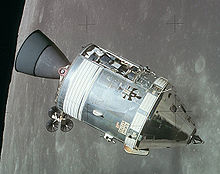
The first manned spacecraft was Vostok 1, which carried Soviet cosmonaut Yuri Gagarin into space in 1961, and complete a full Earth orbit. There were five other manned missions which used a Vostok spacecraft.[2] The second manned spacecraft was named Freedom 7, and it performed a sub-orbital spaceflight carrying American astronaut Alan Shepard to an altitude of just over 187 kilometres (116 mi). There were five other manned missions using Mercury spacecraft.
Other Soviet manned spacecraft include the Voskhod and Soyuz, and the Salyut and Mir space stations. Other American manned spacecraft include the Gemini Spacecraft, Apollo Spacecraft, the Skylab space station, and the Space Shuttle. China developed the Shenzhou spacecraft, which as of January 2011 has been used for three manned missions, the first being Shenzhou 5 in 2003.
The International Space Station, manned since November 2000, is a joint venture between Russia, the United States, and several other countries.
Spaceplanes
[edit]
Some reusable vehicles have been designed only for manned spaceflight, and these are often called spaceplanes. The first example of such was the North American X-15 spaceplane, which conducted two manned flights which reached a height over 100 km in the 1960's. The first reusable spacecraft, the X-15, was air-launched on a suborbital trajectory on July 19, 1963.
The first partially reusable orbital spacecraft, the Space Shuttle, was launched by the USA on the 20th anniversary of Yuri Gagarin's flight, on April 12, 1981. During the Shuttle era, six orbiters were built, all of which have flown in the atmosphere and five of which have flown in space. The Enterprise was used only for approach and landing tests, launching from the back of a Boeing 747 SCA and gliding to deadstick landings at Edwards AFB, California. The first Space Shuttle to fly into space was the Columbia, followed by the Challenger, Discovery, Atlantis, and Endeavour. The Endeavour was built to replace the Challenger when it was lost in January 1986. The Columbia broke up during reentry in February 2003.
The first automatic partially reusable spacecraft was the Buran (Snowstorm), launched by the USSR on November 15, 1988, although it made only one flight. This spaceplane was designed for a crew and strongly resembled the U.S. Space Shuttle, although its drop-off boosters used liquid propellants and its main engines were located at the base of what would be the external tank in the American Shuttle. Lack of funding, complicated by the dissolution of the USSR, prevented any further flights of Buran. The Space Shuttle has since been modified to allow for autonomous re-entry in case of necessity.
Per the Vision for Space Exploration, the Space Shuttle is due to be retired in 2011 due mainly to its old age and high cost of program reaching over a billion dollars per flight. The Shuttle's human transport role is to be replaced by the partially reusable Crew Exploration Vehicle (CEV) no later than 2014. The Shuttle's heavy cargo transport role is to be replaced by expendable rockets such as the Evolved Expendable Launch Vehicle (EELV) or a Shuttle Derived Launch Vehicle.
Scaled Composites' SpaceShipOne was a reusable suborbital spaceplane that carried pilots Mike Melvill and Brian Binnie on consecutive flights in 2004 to win the Ansari X Prize. The Spaceship Company will build its successor SpaceShipTwo. A fleet of SpaceShipTwos operated by Virgin Galactic should begin reusable private spaceflight carrying paying passengers in 2011.
XCOR Aerospace also plans to initiate a suborbital commercial spaceflight service with the Lynx rocketplane in 2012 through a partnership with RocketShip Tours. First test flights are planned for 2011.
Unmanned spacecraft
[edit]
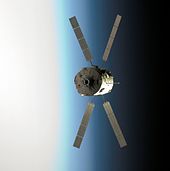
This section needs expansion. You can help by adding to it. (March 2011) |
- Semi-manned or manned-spec unmanned spacecraft
- Automated Transfer Vehicle (ATV) – unmanned European cargo spacecraft
- Buran manned-spec[clarification needed] Soviet shuttle (one mission only)
- H-II Transfer Vehicle (HTV) – unmanned Japanese cargo spacecraft
- Progress – unmanned USSR/Russia cargo spacecraft
- TKS – manned-spec[clarification needed] unmanned USSR cargo spacecraft
- Earth Orbit
- Explorer 1 – first US satellite
- Project SCORE – first communications satellite
- SOHO
- Sputnik 1 – world's first artificial satellite
- Sputnik 2 – first animal in orbit (Laika)
- Sputnik 5 – first capsule recovered from orbit (Vostok precursor) – animals survived
- STEREO – Earth environment observation
- Syncom – first geosynchronous communications satellite
- X-37 – spaceplane
- There are more than 2,000 spacecrafts in orbit.
- Lunar
- Clementine – US Navy mission, orbited Moon, detected hydrogen at the poles
- Kaguya JPN – Lunar orbiter
- Luna 1 – first lunar flyby
- Luna 2 – first lunar impact
- Luna 3 – first images of lunar far side
- Luna 9 – first soft landing on the Moon
- Luna 10 – first lunar orbiter
- Luna 16 – first unmanned lunar sample retrieval
- Lunar Orbiter – very successful series of lunar mapping spacecraft
- Lunar Prospector – confirmed detection of hydrogen at the lunar poles
- Lunar Reconnaissance Orbiter – Identifies safe landing sites & Locates moon resources
- SMART-1 ESA – Lunar Impact
- Surveyor – first USA soft lander
- Chandrayaan 1 – first Indian Lunar mission
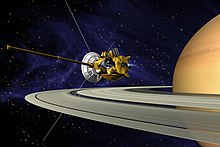
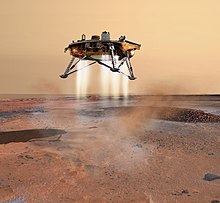
- Planetary
- Akatsuki JPN – a Venus orbiter
- Cassini-Huygens – first Saturn orbiter + Titan lander
- Galileo – first Jupiter orbiter+descent probe
- IKAROS JPN – first solar-sail spacecraft
- Mariner 4 – first Mars flyby, first close and high resulution images of Mars
- Mariner 9 – first Mars orbiter
- Mariner 10 – first Mercury flyby, first close up images
- Mars Exploration Rover – a Mars rover
- Mars Express – a Mars orbiter
- Mars Global Surveyor – a Mars orbiter
- Mars Reconnaissance Orbiter – an advanced climate, imaging, sub-surface radar, and telecommunications Mars orbiter
- MESSENGER – first Mercury orbiter (arrival 2011)
- Mars Pathfinder – a Mars lander + rover
- New Horizons – first Pluto flyby (arrival 2015)
- Pioneer 10 – first Jupiter flyby, first close up images
- Pioneer 11 – second Jupiter flyby + first Saturn flyby (first close up images of Saturn)
- Pioneer Venus – first Venus orbiter+landers
- Vega 1 - Balloon release into Venus atmosphere and lander (joint mission with Vega 2), mothership continued on to rendesvous with Halley's Comet [3]
- Venera 4 – first soft landing on another planet (Venus)
- Viking 1 – first soft landing on Mars
- Voyager 2 – Jupiter flyby + Saturn flyby + first flybys/images of Neptune and Uranus
- Other – deep space
- Fastest spacecraft
- Helios I & II Solar Probes (252,792 km/h / 157,078 mph)
- Furthest spacecraft from the Sun
- Voyager 1 at 106.3 AU as of July 2008, traveling outward at about 3.6 AU/year
- Pioneer 10 at 89.7 AU as of 2005, traveling outward at about 2.6 AU/year
- Voyager 2 at 85.49 AU as of July 2008, traveling outward at about 3.3 AU/year
Unfunded / canceled programs
[edit]
- Multi-stage
- Chinese Project 921-3 Shuttle
- Kliper—Russian "Clipper"
- ESA Hermes Shuttle
- Soviet Buran Shuttle
- Soyuz Kontakt
- Teledesic
- Manned Orbiting Laboratory
- X-20
- Altair - lunar lander
- RR/British Aerospace HOTOL
- ESA Hopper Orbiter
- McDonnell Douglas DC-X (Delta Clipper)
- Roton Rotored-Hybrid
- Lockheed-Martin VentureStar
Spacecraft under development
[edit]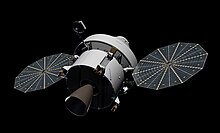
Manned
[edit]- Orion - capsule
- SpaceX Dragon - capsule
- Lynx rocketplane - suborbital
- ISRO Orbital Vehicle - capsule
- PTK NP spacecraft- capsule
- Dream Chaser - spaceplane
- Prometheus - spaceplane
- SpaceShipTwo - spaceplane
- Boeing CST-100 - capsule
- proposed ESA Advanced Reentry Vehicle - capsule
- Skylon - single-stage-to-orbit spaceplane
Unmanned
[edit]- SpaceX Dragon - cargo delivery to the ISS
- Orbital Sciences Cygnus - cargo delivery to the ISS
- CNES Mars Netlander
- James Webb Space Telescope (delayed)
- ESA Darwin probe
- Mars Science Laboratory rover
- Shenzhou spacecraft Cargo
- Terrestrial Planet Finder probe
- System F6—a DARPA Fractionated Spacecraft demonstrator
Subsystems
[edit]A spacecraft system comprises various subsystems, dependent upon mission profile. Spacecraft subsystems comprise the spacecraft "bus" and may include: attitude determination and control (variously called ADAC, ADC or ACS), guidance, navigation and control (GNC or GN&C), communications (Comms), command and data handling (CDH or C&DH), power (EPS), thermal control (TCS), propulsion, and structures. Attached to the bus are typically payloads.
- Life support
- Spacecraft intended for human spaceflight must also include a life support system for the crew.
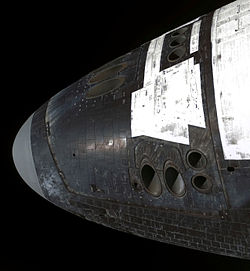
- Attitude control
- A Spacecraft needs an attitude control subsystem to be correctly oriented in space and respond to external torques and forces properly. The attitude control subsystem consists of sensors and actuators, together with controlling algorithms. The attitude control subsystem permits proper pointing for the science objective, sun pointing for power to the solar arrays and earth-pointing for communications.
- GNC
- Guidance refers to the calculation of the commands (usually done by the CDH subsystem) needed to steer the spacecraft where it is desired to be. Navigation means determining a spacecraft's orbital elements or position. Control means adjusting the path of the spacecraft to meet mission requirements. On some missions, GNC and Attitude Control are combined into one subsystem of the spacecraft.
- Command and data handling
- The CDH subsystem receives commands from the communications subsystem, performs validation and decoding of the commands, and distributes the commands to the appropriate spacecraft subsystems and components. The CDH also receives housekeeping data and science data from the other spacecraft subsystems and components, and packages the data for storage on a data recorder or transmission to the ground via the communications subsystem. Other functions of the CDH include maintaining the spacecraft clock and state-of-health monitoring.
- Power
- Spacecraft need an electrical power generation and distribution subsystem for powering the various spacecraft subsystems. For spacecraft near the Sun, solar panels are frequently used to generate electrical power. Spacecraft designed to operate in more distant locations, for example Jupiter, might employ a Radioisotope Thermoelectric Generator (RTG) to generate electrical power. Electrical power is sent through power conditioning equipment before it passes through a power distribution unit over an electrical bus to other spacecraft components. Batteries are typically connected to the bus via a battery charge regulator, and the batteries are used to provide electrical power during periods when primary power is not available, for example when a Low Earth Orbit (LEO) spacecraft is eclipsed by the Earth.
- Thermal control
- Spacecraft must be engineered to withstand transit through the Earth's atmosphere and the space environment. They must operate in a vacuum with temperatures potentially ranging across hundreds of degrees Celsius as well as (if subject to reentry) in the presence of plasmas. Material requirements are such that either high melting temperature, low density materials such as beryllium and reinforced carbon-carbon or (possibly due to the lower thickness requirements despite its high density) tungsten or ablative carbon/carbon composites are used. Depending on mission profile, spacecraft may also need to operate on the surface of another planetary body. The thermal control subsystem can be passive, dependent on the selection of materials with specific radiative properties. Active thermal control makes use of electrical heaters and certain actuators such as louvers to control temperature ranges of equipments within specific ranges.
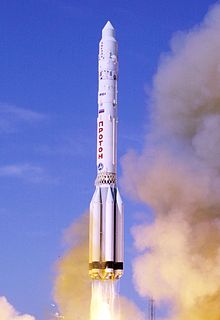
- Propulsion
- Spacecraft may or may not have a propulsion subsystem, depending upon whether or not the mission profile calls for propulsion. The Swift spacecraft is an example of a spacecraft that does not have a propulsion subsystem. Typically though, LEO spacecraft (for example Terra (EOS AM-1) include a propulsion subsystem for altitude adjustments (called drag make-up maneuvers) and inclination adjustment maneuvers. A propulsion system is also needed for spacecraft that perform momentum management maneuvers. Components of a conventional propulsion subsystem include fuel, tankage, valves, pipes, and thrusters. The TCS interfaces with the propulsion subsystem by monitoring the temperature of those components, and by preheating tanks and thrusters in preparation for a spacecraft maneuver.
- Structures
- Spacecraft must be engineered to withstand launch loads imparted by the launch vehicle, and must have a point of attachment for all the other subsystems. Depending upon mission profile, the structural subsystem might need to withstand loads imparted by entry into the atmosphere of another planetary body, and landing on the surface of another planetary body.
- Payload
- The payload is dependent upon the mission of the spacecraft, and is typically regarded as the part of the spacecraft "that pays the bills". Typical payloads could include scientific instruments (cameras, telescopes, or particle detectors, for example), cargo, or a human crew.
- Ground segment
- The ground segment, though not technically part of the spacecraft, is vital to the operation of the spacecraft. Typical components of a ground segment in use during normal operations include a mission operations facility where the flight operations team conducts the operations of the spacecraft, a data processing and storage facility, ground stations to radiate signals to and receive signals from the spacecraft, and a voice and data communications network to connect all mission elements.[4]
- Launch vehicle
- The launch vehicle propels the spacecraft from the Earth's surface, through the atmosphere, and into an orbit, the exact orbit being dependent upon mission configuration. The launch vehicle may be expendable or reusable.
See also
[edit]- Timeline of Solar System exploration
- Astrionics
- List of spacecraft
- List of spaceflights
- Spacecraft design
- Spacecraft propulsion
- Space exploration
- U.S. Space Exploration History on U.S. Stamps
- Space suit
- Spaceflight records
- Starship
- Ansari X Prize
- Atmospheric reentry
- Earth to orbit
- List of fictional spacecraft
- Flying saucers
References
[edit]- ^ F.J. Krieger (October 5, 1957). ""Announcement of the First Satellite," from Pravada". NASA.
- ^ "Vostok". Encyclopedia Astronautica.
- ^ http://en.wikipedia.org/wiki/Vega_1
- ^ "The Rosetta ground segment". ESA.int. 2004-02-17. Retrieved 2008-02-11.
- Wertz, James (1999). Space Mission Analysis and Design (3rd ed.). Torrance, CA: Microcosm. ISBN 978-1881883104.
{{cite book}}: Unknown parameter|coauthors=ignored (|author=suggested) (help) - Knight, Will (2006-01-23). "Spacecraft skin 'heals' itself". New Scientist. Retrieved 2008-02-11.
